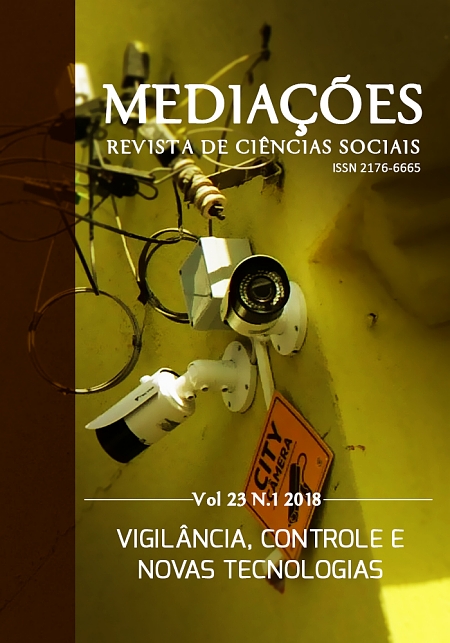Movimientos sociales, policía y vigilancia: un diálogo teórico por construir
DOI:
https://doi.org/10.5433/2176-6665.2018v23n1p100Palabras clave:
Movimientos sociales, Vigilancia, ControlResumen
El presente estudio busca explicar cómo se constituyen las relaciones entre el campo de estudios sobre la acción colectiva y el campo de estudios sobre la vigilancia, específicamente en lo que se refiere al tema de la vigilancia de los movimientos sociales. A partir de un análisis centrado centralmente en la revisión bibliográfica de las dos principales revistas internacionales de cada área (Mobilization y Surveillance & Society) y con la ayuda del software NVivo 11, el objetivo es investigar en qué medida estos diferentes campos (no) producir un diálogo teórico entre sí. Luego de explicar las brechas específicas en cada campo, se concluye que existe la necesidad de construir un diálogo teórico más amplio basado en conceptos que puedan interconectar estos campos, como “control”, “poder” y “asimetría”.Descargas
Citas
BARKAN, Steven. Criminal prosecution and the legal control of protest. Mobilization, San Diego, v. 11, n. 1, p. 181-195, 2006.
BENNETT, W. Lance; SEGERBERG, Alexandra. The logic of connective action. Information, Communication & Society, London, v. 15, n. 5, p. 739-768, 2012.
BOTELLO, Nelson Arteaga. Surveillance studies: an agenda for Latin America. Surveillance & Society, Chapel Hill, v. 10, n. 1, p. 5-17, 2012.
BRUNO, Fernanda. Máquinas de ver, modos de ser: vigilância, tecnologia e subjetividade. Porto Alegre: Sulina, 2013.
CATTANI, Antonio David (Org.). Protestos: análises das ciências sociais. Porto Alegre: Tomo Editorial, 2014.
COHEN, Stanley. Visions of social control. Cambridge: Polity Press, 1985.
COSTA, Jairo. A tática do black bloc. Revista Mortal, São Paulo, 2013.
DAVENPORT, Christian; EADS, Marci. Cued to Coerce or coercing cues? An exploration of dissident rhetoric and its relationship to political repression. Mobilization, San Diego, v. 6, n. 2, p. 151-171, 2001.
DELEUZE, Gilles. Conversações: 1972-1990. São Paulo: Ed. 34, 1992.
DELLA PORTA, Donatella; FILLIEULE, Olivier. Policing social protest. In: SNOW, David; SOULE, Sarah; KRIESI, Hanspeter (Ed.). The blackwell companion to social movements. Malden: Blackwell Publishing, 2004. p. 217-241.
DELLA PORTA, Donatella; PETERSON, Abby; REITER, Herbert. Policing Transnational Protest: An Introduction. In: DELLA PORTA, Donatella; PETERSON, Abby; REITER, Herbert.The policing of transnational protest. Aldershot: Ashgate, 2006. p. 97-210.
DELLA PORTA, Dontatella; REITER, Herbert. Policing protest: the control of mass demonstrations in Western democracies. Minneapolis: University of Minnesota Press, 1998.
DUPUIS-DÉRI, Francis. Black blocs. São Paulo: Veneta, 2014.
EARL, Jennifer. Controlling protest: new directions for research on the social control of protest. Research in Social Movements, Conflicts and Change, [S. l.], v. 25, p. 55-83, 2004.
EARL, Jennifer. Introduction: repression and the social control of protest. Mobilization, San Diego, v. 11, n. 2, p. 129-143, 2006.
EARL, Jennifer. Political repression: iron fists, velvet gloves and diffuse control. Annual Review Sociology, Palo Alto, v. 37, p. 261-284, 2011.
EARL, Jennifer. Tanks, Tear gas, and taxes: toward a theory of movement repression. Sociological Theory, New York, v. 21, n. 1, 2003.
EARL, Jennifer; SCHUSSMAN, Alan. Cease and desist: repression, strategic voting and the 2000 U.S. Presidential Election. Mobilization, San Diego, v. 9, n. 2, p. 181-202, 2004.
FERNANDEZ, Luis A. Policing dissent: social control and the anti-globalization movement. London: Rutgers University Press, 2008.
FERNANDEZ, Luis A; HUEY, Laura. Is resistance futile? thoughts on resisting surveillance. Surveillance & Society, Chapel Hill, v. 6, n. 3, p. 198-202, 2009.
FONSECA, Bruno. Vigilância em números. Pública, 31 jan. 2017. Disponível em: https://apublica.org/vigilancia/vigilancia-em-numeros/. Acesso em: 17 jul. 2017.
FOUCAULT, Michel. Vigiar e punir: nascimento da prisão. Petrópolis: Vozes, 2002.
GAFFNEY, Christopher. Segurança pública e os megaeventos no Brasil. In: SANTOS JÚNIOR, Orlando Alves et al. (Org.). Brasil: os impactos da Copa do Mundo 2014 e das Olimpíadas 2016. Rio de Janeiro: Observatório das Metropoles, 2015.
GANDY, Oscar H. The panoptic sort: a political economy of personal information. Boulder, CO: Westview Press, 1993.
GARLAND, David. The culture of control: crime and social order in contemporary society. Oxford: Oxford University Press, 2001.
GILLHAM, Patrick F.; EDWARDS, Bob; NOAKES, John A. Strategic incapacitation and the policing of occupy Wall Street protests in New York City, 2011. Policing and Society, Southampton, v. 23, n. 11, p. 81-102, 2013.
GOLDSMITH, Andrew J. Policing’s new visibility. British Journal of Criminology, London, v. 50, n. 5, p. 914-934, 2010.
KOOPMANS, Ruud. Dynamics of repression and mobilization: the German extreme right in the 1990s. Mobilization, San Diego, v. 2, n. 2, p. 149-164, 1997.
LATOUR, Bruno. Jamais fomos modernos: ensaio de antropologia simétrica. Rio de Janeiro: Ed. 34, 2013.
LYON, David. Surveillance society: monitoring everyday life. Oxford: Open University Press, 2001.
MARICATO, Ermínia et al. Cidades rebeldes: passe livre e as manifestações que tomaram as ruas do Brasil. São Paulo: Boitempo, 2013.
MARX, Gary T. Undercover. Berkeley: University of California Press, 1988.
MOBILIZATION: AN INTERNATIONAL QUARTERLY. Disponível em: http://mobilizationjournal.org/?code=hjdm-site. Acesso em: 23 jul. 2017.
MONAHAN, Torin. Counter-surveillance as political intervention? Social Semiotics, Sweden, v. 16, n. 4, p. 515-534, 2006.
NOAKES, John; GILLHAM, Patrick. Aspects of the new penology in the police response to major political protests in the United States, 1999-2000. In: DELLA PORTA, Donatella; PETERSON, Abby; REITER, Herbert (Ed.). The policing of transnational protest. Aldershot: Ashgate, 2006. p. 97-210.
NORRIS, Clive; ARMOSTRONG, Gary. The maximum surveillance society: the rise of CCTV. Oxford: Berg, 1999.
ROLLSING, Carlos. BBB da brigada. Zero Hora, Porto Alegre, 14 jun. 2014.
RULE, James B. Private lives, public surveillance: social control in the information age. London: Allen Lane, 1973.
SERISIER, Tanya; WILSON, Dean. Video activism and the ambiguities of counterSurveillance. Surveillance & Society, Chapel Hill, v. 8, n. 2, p. 166-180, 2010.
SILVA, Marcelo K. #vemprarua: o ciclo de protestos de 2013 como expressão de um novo padrão de mobilização contestatória? In: CATTANI, Antonio David (Org.). #protestos: análises das ciências sociais. Porto Alegre: Tomo Editorial, 2014.
TARROW, Sidney. Global, conventional and warring movements and the suppression of contention. Themes in contentious politics research. Política & Sociedade, Florianópolis, v. 10, n. 18, p. 25-49, 2011.
TARROW, Sidney. Poder em movimento: movimentos sociais e confronto político. Petrópolis: Vozes, 2009.
TILLY, Charles. From mobilization to revolution. Reading, Mass: Addison-Wesley, 1978.
WOOD, David. Situating Surveillance studies. Surveillance & Society, Chapel Hill, v. 19, p. 52-61, 2009.
ZUBOFF, Soshana. In the age of the smart machine. New York: Basic Books, 1989.
Descargas
Publicado
Cómo citar
Número
Sección
Licencia
Derechos de autor 2018 Eduardo Fernandes

Esta obra está bajo una licencia internacional Creative Commons Atribución 4.0.
Los derechos de autor de los artículos publicados en Mediations son del autor; En caso de republicación parcial o total de la primera publicación, se solicita a los autores que indiquen la publicación original en la revista.
Mediações utiliza la licencia Creative Commons Attribution 4.0 International, que proporciona acceso abierto, permitiendo a cualquier usuario leer, descargar, copiar y difundir su contenido, siempre que esté debidamente referenciado.
Las opiniones emitidas por los autores de los artículos son de su exclusiva responsabilidad.
































